Accessible Golf Courses - A Summary of Accessibility Guidelines for Recreation Facilities
Accessible Routes
Accessible routes are continuous, unobstructed paths connecting all accessible elements and spaces of a building or facility on golf courses. The accessible route must comply with ADAAG provisions for location, width (minimum of 36 inches), passing space, head room, surface, slope (maximum of 1:12 or 8.33%), changes in level, doors, egress, and areas of rescue assistance, unless modified by specific provisions outlined in this guide.
Alternative Golf Car Passage
Providing an accessible route that complies with ADAAG may be impractical throughout a golf course for several reasons. First, the route of play for a golfer is dependent on where the ball lands and is therefore unpredictable. The guidelines assume that on many courses, golfers use a golf car to move throughout the course.
Second, requiring an accessible route throughout a course could alter the slopes within some courses and alter the nature of the sport by eliminating some of the challenge of the game. Therefore, a golf car passage may be substituted for an accessible route within the boundary of a golf course. A golf car passage is a continuous passage on which a motorized golf car can operate. While a golf car passage must be usable by golf cars, it does not necessarily need to have a prepared surface and may be part of a golf car path.
The golf car passage could be located on areas such as fairways, greens, and teeing surfaces. A golf car passage can be substituted for all or part of the accessible route connecting elements within the boundary of the course and must be a minimum of 48 inches in width.
A golf car passage may also be substituted for an accessible route outside the boundary of the golf course when connecting certain elements. This is limited to the golf car rental area, bag drop areas, practice putting greens, accessible practice teeing grounds, course toilet rooms, and course weather shelters.
Accessible Route Guidelines
Where an accessible route is used, the golf course guidelines modify ADAAG’s accessible route provisions. They increase the minimum width for an accessible route from 36 inches to 48 inches. If an accessible route is provided instead of a golf car passage, it must connect accessible elements and spaces located within the boundary of a golf course. The 48-inch minimum width for the accessible route is necessary to ensure passage of a golf car on the accessible route. This is important where the accessible route is used to connect the golf car rental area, bag drop areas, practice putting greens, accessible practice teeing grounds, course toilet rooms, and course weather shelters. These are areas outside the boundary of the golf course, but are areas where an individual using an adapted golf car may travel. Where handrails are provided along an accessible route, the guidelines increase the minimum width of the route to 60 inches to accommodate the passage of a golf car.
Course Barriers
Curbing or other man-made barriers often line golf car paths to restrict golf cars from entering certain portions of the course or to reduce erosion. Where man-made barriers are provided that prevent golf cars from entering a fairway, openings at least 60 inches wide at intervals not exceeding 75 yards must be provided. These dispersed openings will provide access to the course at reasonable intervals, enabling a golfer using a golf car to play the game without extended travel distances and time requirements.

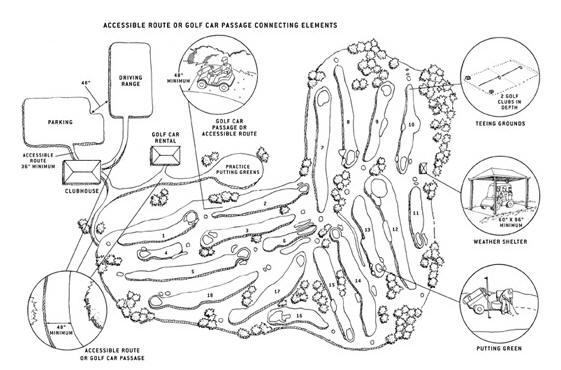
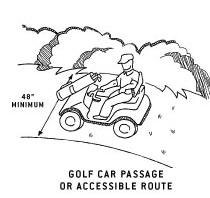
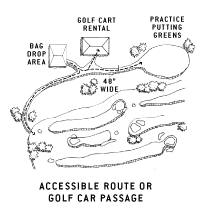
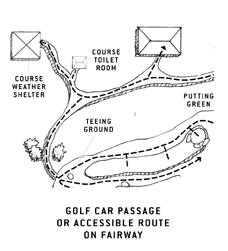
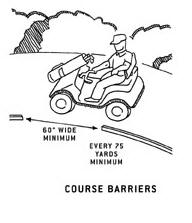
User Comments/Questions
Add Comment/Question